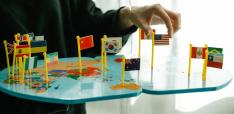Countering Weaponized Interdependence with Co-Optive Interdependence

Daniele Carminati investigates to what extent China’s Belt and Road Initiative could be seen as a collaborative alternative to coercive interdependence.
In 2019, Farrell and Newman introduced the concept of “weaponized interdependence”. Interdependence has been a subject of studies for decades, most notably by Nye and Keohane, especially in the context of growing globalization and the information age. While some opportunities and perils associated with interdependence were already known, Farrell and Newman provided an overview of how “asymmetric network structures [enable] some states to leverage interdependent relations to coerce others.” This is the hard (power) side of the phenomenon.
Scholars like Nye and Keohane initially recognized how “complex interdependence,” such as through trade or knowledge sharing, can reduce the likelihood of conflicts while still recognizing that asymmetries can lead to exploitation and discontent. Similarly, Anne-Marie Slaughter claimed that globalization has led to the creation of decentralized networks that have opened up new opportunities for cooperative diplomacy. This approach, what can be referred to as “co-optive interdependence,” is based on cooperative networks rather than exploitative ones, representing the soft (power) side.
How do weaponized and co-optive interdependence differ conceptually and practically, especially within dynamics of power? Drawing upon the work of Pansardi and Bindi, the former can be understood as a manifestation of ‘power-over’, an “asymmetrical relation between two or more actors or group of actors,” or ‘power-to’, as “the ability of the actor herself to carry out certain specific outcomes.” The latter is better described as ‘power-with’, the “ability of a group to act together in view of collective outcomes or goals.”
Interdependence, in a more practical sense, relies on global connectivity channels. Gaens, Sinkkonen, and Vogt offered an analytical framework to assess the behavior of international actors in this context. They identified six “logics of connectivity” that can arise from complex interdependence: cooperation, copying, cushioning, contestation, containment, and coercion.
Among these, the ones that better reflect weaponization – as coercive hard power – are: contestation, when actors try to “gain advantages over others within specific spheres of connectivity”; containment, when attempting “to exclude, to disconnect, another actor or group of actors, or considerably circumscribe its ability to act within a particular sphere”; and plain coercion, as “the infliction of pain or damage – or the withdrawal of something valued, such as patronage or affection – to compel an actor to behave in a particular way.”
Conversely, soft power dynamics of attraction and co-option are reflected in the other logics, such as cooperation, as the “creation of inclusive mutually beneficial connective networks,” copying, when “enhancing connectability by emulating others,” and to a lesser extent cushioning, when “broadening the range of options through connectivity to mitigate risks.”
Co-optive interdependence involves creating appealing connectivity channels that lead to mutually advantageous win-win outcomes, even if not shared evenly. On the other hand, weaponized interdependence typically results in win-lose outcomes because the coerced party will have to compromise on its national interest. In some cases, connectivity channels will be halted or even severed, although this can lead to lose-lose outcomes, so it is an extreme option.
What are some tangible examples of weaponized and co-optive interdependence?
The U.S. and China present diverse scenarios. In 2019, when Farrell and Newman’s initial article was published, the authors argued that the E.U. and other nations “benefit more than they suffer from the U.S. exercise of network hegemony,” acknowledging the existence of co-optive interdependence. The article specifically mentioned the SWIFT financial system, counterterrorism, and nonproliferation. However, fast forward to Trump 2.0, and things have changed significantly. Depending on who you ask, China and the U.S. can be seen as providers of both advantageous and disruptive interdependence dynamics. Notably, the U.S. remains the most prominent actor wielding structural power in various forms, such as through the dominance of the U.S. dollar and a global surveillance network.
Farrell and Newman argue that the most prominent manifestations of weaponized interdependence rely on the “panopticon and chokepoint effects of networks.” The former happens when “advantaged states use their network position to extract informational advantages over adversaries, whereas in the latter, they can cut adversaries off from network flows.” In short, exploitation of exclusion. More specifically, they explain how these mechanisms operate through “financial messaging and internet communications”, which serve as the “vanguard of decentralized economic networks.”
Beyond the U.S., a massive and multidimensional endeavor like China’s Belt and Road Initiative (BRI) could further amplify this phenomenon by developing and controlling various connectivity channels, encompassing physical and digital infrastructure, sociocultural ties and narratives, and business networks. China provides substantial financial assistance to establish connectivity channels, ultimately leading to interdependence. This illustrates the dual nature of connectivity as an enabler or disabler. If the BRI brings shared prosperity through cooperation, it is a case of ‘power with’ (soft power through co-optive interdependence). Conversely, if it is a show of coercive might, it is a manifestation of ‘power over’ or ‘power to’ (hard power through weaponized interdependence).
As for the US in the domains mentioned above, China controls BRI-established connectivity channels, but it is in Beijing’s interest to deliver win-win outcomes aligned with its rhetoric, as recognition from receiving countries could boost its reputation globally. Instead, exploiting and weaponizing BRI connectivity channels will lead to complaints from affected countries while also supporting rival narratives, such as accusations of debt entrapment.
Due to this dual nature of interdependence, on which bases do states decide whether to weaponize their connections or not? And what are the potential implications for these powerful connectors and the connected ones?
For the most part, states are in control of patterns of hard and soft empowerment and disempowerment through interdependence. As Trump’s America First policy demonstrates, there may be initial gains, but many observers anticipate long-term losses. Erratic behavior swiftly erodes a country’s reputation, particularly the U.S., which is no longer perceived as reliable. Few countries, if any, can stand up to the U.S. in the short term, However, the more Washington “turned interconnections against its adversaries, the more likely it was that these adversaries–and even allies–would disconnect, hide, or retaliate.” After all, persistent coercion, sometimes referred to as bullying, leads to resentment and reassessment towards diversification
Ultimately, the decision to use connections to coerce (win-lose weaponization) or in concert (win-win collaboration) is in the hands of a few powerful connectors managing old and new networks, like the U.S. and China. Researchers and policymakers alike may want to investigate questions such as: does ‘weaponizable’ inevitably lead to ‘weaponized’? Is weaponization worth the risks in the long term? “How much ‘weaponization’ can the global economy take” till it is no longer sustainable?
Farrell and Newman, among others, recognize and warn that weaponization is unsustainable and eventually lose-lose. Notably, the authors remind us that the “enduring paradox of structural power [i.e. interdependence] is that it is most effective when it is not explicitly used.” For the time being, however, the Trump administration (or Trump himself) appears to believe that the short-term coercive gains derived from weaponized interdependence outweigh the long-term gains that could be achieved through co-optive interdependence.
Despite challenges, instead, China’s connectivity masterplan seems to be yielding results, leading to co-option, especially in developing nations, while accusations of debt entrapment have been repeatedly debunked. Does this mean that China will not weaponize these new BRI connectivity channels? This is still a matter of debate, as evidence suggests trade is being weaponized already. Yet, in the meantime, China’s recent reputational gains are attributed more to Washington’s coercive moves than to Beijing’s charm offensives.
In the end, the overarching question is whether this is merely an anomaly or if we are returning to an era where might makes right. Either way, the U.S.’ abandonment of constructive engagement on global issues could further signal the end of the American Century, leaving the task of rebuilding better connections to a coalition of wealthy and developing nations.
Daniele Carminati - Lecturer, International Relations and Global Affairs, Mahidol University International College.
Photo by Miguel Á. Padriñán


